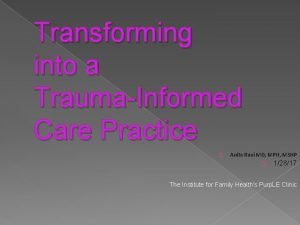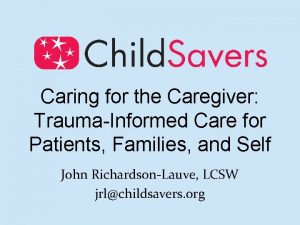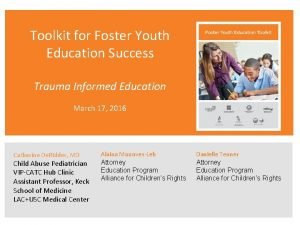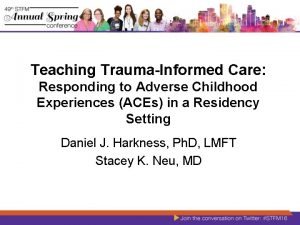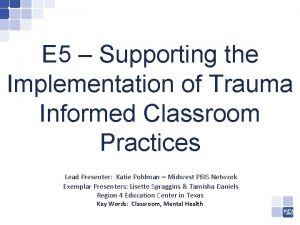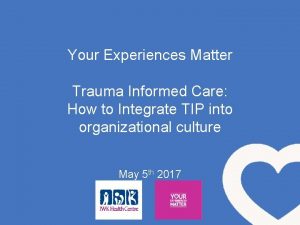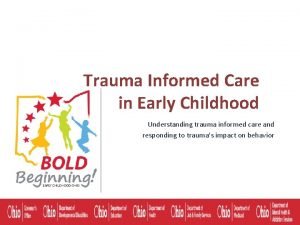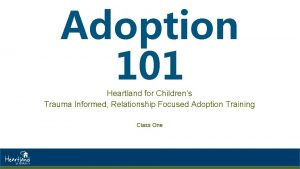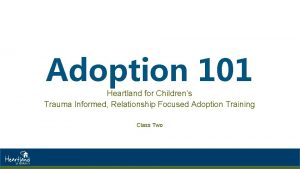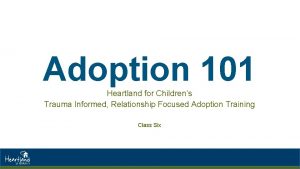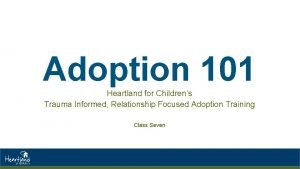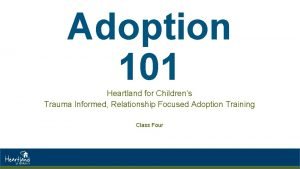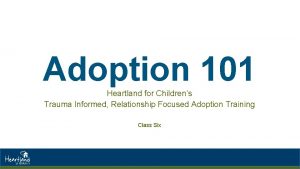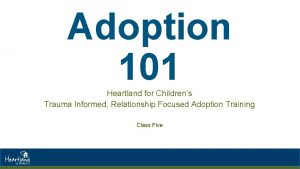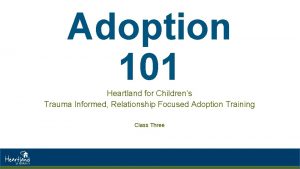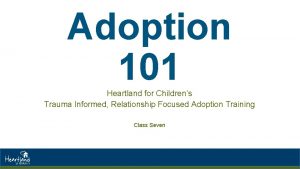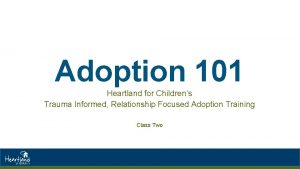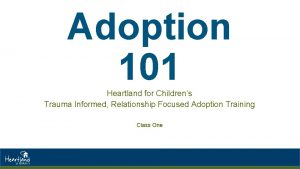Adoption 101 Heartland for Childrens Trauma Informed Relationship













- Slides: 13

Adoption 101 Heartland for Children’s Trauma Informed, Relationship Focused Adoption Training Class Six

Welcome To Adoption 101, Class Six! • Welcome back! • Discussion of last week & homework • Today’s Agenda! • Guest Speaker • Connecting Principles

Connecting Principles The foundation for building a trusting relationship between an adult and a child is through connection.

Connecting Principles of TBRI© • These principles address the relational needs of children from hard places who often have experienced trauma through relationships. • Often, a child’s needs are misinterpreted due to their inability to verbalize their needs. Tune into your child! See beyond the behavior. • What is my child trying to tell me? • What does my child really need?

Awareness is the Key! • Observational awareness and self-awareness are critical in your ability to recognize the needs of your child, and your own needs. • It can be difficult to be attuned and aware of your child’s needs if your needs are unmet. It also can lead to misinterpretation and/or overreaction, causing more stress for both the parent and the child.

A Key Component of Connection is through PLAY! • Playful engagement disarms fear, promotes attachment, and builds social competence. Did you know 80% of behaviors can be corrected through play? • What exactly do we mean by connection & play? • Think to yourself, how comfortable am I with play? • Do I direct play, or allow the child to take the lead? • Do I try and problem solve? • Am I distracted and not fully engaged during play?

Key Components of Engagement • What do we mean by engagement? • • • Eye contact Healthy Touch Tone of Voice Observant Behavioral Matching

It’s the little things… • We must understand that STAYING (connection) is more important than stopping a behavior. The priority is the relationship first; then everything else. • If your first objective is to be right or punitive; you are not regulated and looked at their behavior through the child’s lens. • Building trust is necessary for change! If a child has been hurt in a relationship, the child can only be healed in a relationship.

It’s a circular process with you at the forefront! Ability to align your own internal state with that of another, through verbal and non verbal communication. With attunement comes coregulation, trust & growth. Unconditional Commitment Attunement Commitment & Acceptance leads to a child’s security physically and emotionally. Now with commitment, acceptance, & security can relationships begin to develop. Express Unconditional Commitment NO MATTER WHAT! Acceptance Security YOU must accept and acknowledge that trauma & attachment are driving the behaviors. It’s not a matter of “trying harder”, but the child learning to trust others & self

Building Attachment Through Meeting Needs • Arousal-Relaxation Cycle • Based on our understanding that trust, security, and attachment are strengthened when a consistent adult caregiver repeatedly meets a child’s needs. • This occurs when a child experiences stress/tension and the caregiver provides comfort and provides for the child’s needs, which relieves tension/stress and promotes contentment. • Should be repeated several times a day. • Can be difficult when their needs are expressed through problematic behaviors. • Positive Interactive Cycle • In this cycle, the child does not need to first express their need. This is when a parent can take the initiative to engage in positive interaction with the child, and thus the child enjoys the experience and reacts in an affirming manner. • With this, both parent and child feel sense of self worth and it greatly helps in the attachment process. • Many adoptive parents believe the child should take the first step in forming attachments, yet these children are often not trusting enough yet to take this step. Adoptive parents need to initiate gentle, non threatening social interactions with a child that are positive, meaningful, and pleasurable to develop attachment.

Connection Tips & Tools • Remember that opportunities for bonding and attachment enhancing activities should not be a “reward”. This should become a ritual despite a challenging day. In fact, children often need connection time more intensely when they are having challenging days! • Fill their YES bank! • Be mindful of overstimulation and ensuring their physiological needs are met. While play is fun, you also want to ensure not to “overdo” it. • Encourage self-regulation by co-regulating with them!

And Most Important…. • You can not give away that which is not yours to give…. . • If you cannot learn how to be regulated yourself – how can you expect the child to do so. You are the child’s model and they learn through your example. • Remember to take time for yourself to relax and become regulated. If you are stressed, the child can sense this! • We are not perfect. When reacting in a way you know you shouldn’t have, you can repair what was done by simply stating: “I am sorry, this is not the parent that I want to be. Can we start over? ” • Provide Unconditional Commitment & Love. Meaning that there is nothing that a child can do to make you give up on him/her. • This is definitely a different way of parenting and while it may be challenging initially – it has been shown to be very successful. Many people become enlightened at their new sense of calm and the new perspective on the world.

Questions? Comments? • Homework: Connecting/Engagement Strategies • Handouts: • • Curiosity, Pleasure And Play: A Neurodevelopmental Perspective Discipline: it’s all about connection Their Anger Will Not Become My Anger Healing the Trauma of Adoption • Thank you!
 Trauma informed advising
Trauma informed advising Trauma informed workplace
Trauma informed workplace Trauma informed practice
Trauma informed practice Kobtion
Kobtion Anita ravi md
Anita ravi md Trauma informed parenting discipline
Trauma informed parenting discipline Trauma-informed questions for clients
Trauma-informed questions for clients Trauma informed care for foster youth
Trauma informed care for foster youth Libby bergman
Libby bergman Trauma-informed care cheat sheet
Trauma-informed care cheat sheet Trauma informed physical environment
Trauma informed physical environment Trauma informed practice
Trauma informed practice 4 r's trauma informed care
4 r's trauma informed care 4 r's trauma informed care
4 r's trauma informed care




